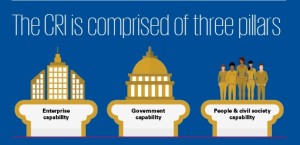Executive Summary. The 2017 CRI is designed to measure how effectively a country’s government, private and public enterprises, people and wider civil society anticipate, prepare for, manage, and respond to change and cultivate opportunity. The 2017 CRI combines data from 26 primary survey questions, gathered from 1,372 country specialists around the world, with a rich secondary dataset made up of more than 125 secondary variables. The Change Readiness Index (CRI) covers 136 countries including the 127 covered in the 2015 CRI plus a combination of additional developed and developing nations.
Country selection
The countries are distributed across a range of income levels. Countries included in this index were selected based on our ability to obtain sufficient or comparable primary and secondary data. The selection of countries provides a useful comparison between the change readiness of advanced and developing nations.
| Country income group | Economies according to GNI per capita | Number of countries (136) | Share in index sample (%) |
| High | >US$12,476 | 35 | 25.7 |
| Upper middle | US$4,036 – $12,475 | 37 | 27.2 |
| Lower middle | US$1,026 – $4,035 | 40 | 29.4 |
| Low | <US$1,025 | 24 | 17.6 |
Scoring methodology
The 2017 CRI is structured around three pillars (enterprise capability, government capability and people and civil society capability), with subindices for each pillar, and primary survey question responses and secondary data variables feeding each subindex score. The composite/overall change readiness score is calculated by weighting standardized pillar scores, which are derived from weighted standardized subindex scores. Subindex scores are derived from standardized primary survey question responses and secondary data, with equal weighting given per variable, whether it is a primary survey question or secondary data indicator.
| Enterprise capability | Government capability |
People & civil society capability |
| Relates to broad capability of private and state-owned enterprises |
Relates to capability of governmental and public regulatory institutions |
Relates to individual, societal and cultural determinants of capability |
| Labor market | Macroeconomic framework | Human capital |
| Economic diversification | Public administration and state business relations |
Entrepreneurship |
| Economic openness | Regulation | Civil society |
| Innovation and R&D | Fiscal and budgeting | Safety nets |
| Business environment | Rule of law | Technology use |
| Financial sector | Government strategic planning and horizon scanning |
Gender |
| Infrastructure | Environment and climate change | Inclusiveness of growth |
| Enterprise sustainability | Food and energy security | Demographics |
| Informal sector | Security | Health |
| Technology infrastructure | Land rights | Access to information |
In addition to the secondary data, between December
2016 and February 2017 Oxford Economics conducted a survey of 1,372
country experts, with 10 per country.
Primary survey experts
For the 2017 CRI, we surveyed individuals with at least 7 years of experience analyzing, studying or living in their reporting country. The individual had to have a good knowledge of economic policymaking, social structures and governance institutions in that country and was not currently employed directly by a government department in the country that directly influences and/or enforces policy making. A minimum of a tertiary-level educational qualification from an accredited university or vocational college degree program was required. Country experts came from a range of industries and sectors, where possible, including senior managers within the private sector, academia and trade unions.
Weighting
To calculate the composite change readiness scores within the Index, each individual indicator (primary or secondary) was first multiplied by its respective equal weighting within its subindex. These weighted scores for each indicator were aggregated to give the corresponding subindex score. Next, each subindex score was multiplied by its equal weighting within its pillar and these weighted subindex scores were aggregated to give the corresponding pillar score.
Each pillar score was then multiplied by an equal weighting factor (one-third), and these weighted pillar scores were then aggregated to give the overall change readiness composite score. For the purposes of this Index, each of the primary survey and secondary data values were normalized into a standard range, facilitating the aggregation of the variables into subindex, pillar, and composite scores. In this case, standardization was achieved by converting raw data values into ‘trimmed Z-scores,’ which were calculated by subtracting the sample mean from the raw score and dividing the result by the standard deviation. The sign of the standardized score indicates whether the raw value for a given country is above or below the sample mean. Outlier values were trimmed to avoid distorting effects using 3 standard deviations as a threshold.
The 2017 CRI uses equal weights throughout the Index for pillars and subindices within pillars. Overall the 2017 Index is weighted 28:72 for primary versus secondary data (26 primary questions and 127 secondary data series). Within each subindex, an equal weighting is given per variable, whether it is a primary survey question or secondary data indicator. In 2015, the index contained 120 secondary data series and 22 primary questions, meaning that although the 2017 index contains more primary and secondary data points, the weighting of primary to secondary data within the index has remained fairly constant this year.
2017 Change Readiness Index heat map
This map provides a world view of change readiness levels in 136 countries. Click on a country to view its entry in the CRI online tool, where you’ll find an in-depth country profile of specific strengths and opportunities, a breakdown of its scores across the three pillars, and country, region, and income-level comparisons. https://home.kpmg.com/xx/en/home/insights/2017/07/2017-change-readiness-index-heat-map.html
KPMG professionals anticipate, innovate and deliver in more than 150 countries around the world. Read about it in the 2016 KPMG International Annual Review. https://home.kpmg.com/xx/en/home/campaigns/2016/12/international-annual-review.html#introduction
